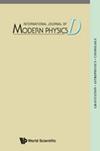Dynamical analysis of the Tsallis holographic dark energy models with event horizon as cut-off and interaction with matter
IF 2.1
4区 物理与天体物理
Q3 ASTRONOMY & ASTROPHYSICS
引用次数: 0
Abstract
The model of generalized Tsallis holographic dark energy (which is known to be particular representative of Nojiri-Odintsov HDE) with event horizon as cut-off is investigated using methods of dynamical analysis. We take into consideration possible interaction with dark energy and matter in various forms. Critical points are determined. Cosmological evolution of the Universe depends from interaction parameters. If we use event horizon scale as cutoff quasi-de Sitter expansion is possible only for interaction of type $\sim H(\alpha\rho_{de}+\beta\rho_{m})$ (where $H$ is the Hubble parameter). For interactions $\sim \rho_m \rho_{de} /H$ and $\sim H \rho_{m}^{\alpha}\rho_{de}^{1-\alpha}$ Universe eventually stops ($H\rightarrow 0$) or ends its existence in final singularity ($H\rightarrow\infty$). In first case fraction of dark energy tends to $1$ or constant value lesser than 1 because dynamical equilibrium between matter and dark energy is established on late times.以视界为截止点和物质相互作用的Tsallis全息暗能量模型的动力学分析
用动力学分析方法研究了以视界为截止点的广义Tsallis全息暗能量模型(它是Nojiri Odintsov HDE的特别代表)。我们考虑了与暗能量和各种形式的物质的可能相互作用。关键点已确定。宇宙的宇宙演化取决于相互作用参数。如果我们使用事件视界尺度作为截止点,则准德西特展开仅对类型为$\sim H(\alpha\rho_{de}+\beta\rho_{m})$的相互作用是可能的(其中$H$是哈勃参数)。对于相互作用$\sim\rho_m\rho_{de}/H$和$\sim H\rho_{m}^{\alpha}\rho_{de}^{1-\alpha}$,宇宙最终停止($H\rightarrow0$)或在最终奇点中结束其存在($H\ rightarrow \infty$)。在第一种情况下,暗能量的分数倾向于$1$或小于1的常数值,因为物质和暗能量之间的动态平衡是在晚期建立的。
本文章由计算机程序翻译,如有差异,请以英文原文为准。
求助全文
约1分钟内获得全文
求助全文
来源期刊

International Journal of Modern Physics D
地学天文-天文与天体物理
CiteScore
3.80
自引率
9.10%
发文量
181
审稿时长
4-8 weeks
期刊介绍:
Gravitation, astrophysics and cosmology are exciting and rapidly advancing fields of research. This journal aims to accommodate and promote this expansion of information and ideas and it features research papers and reviews on theoretical, observational and experimental findings in these fields. Among the topics covered are general relativity, quantum gravity, gravitational experiments, quantum cosmology, observational cosmology, particle cosmology, large scale structure, high energy astrophysics, compact objects, cosmic particles and radiation.
 求助内容:
求助内容: 应助结果提醒方式:
应助结果提醒方式:


